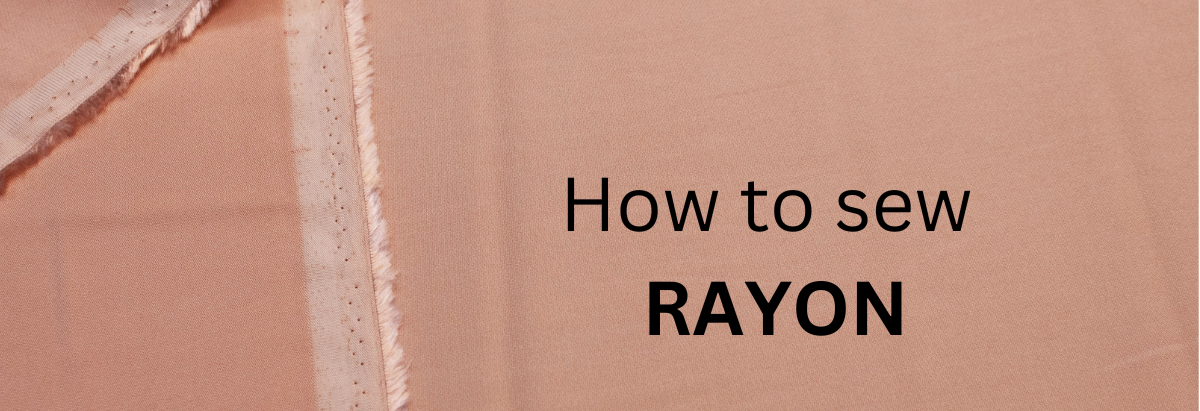
I love Rayon – that is, to see it and wear it. It is soft, lustrous and beautiful. It drapes nicely on the body. But on my home sewing machine, it is, at times, a little frustrating. Missed stitches, frayed seams and difficulty in interfacing are all some of the problems.
Rayon is a manufactured fabric made out of natural fibers. Today a lot of clothes are made of this soft drapey fabric in its different forms – be it under names like viscose, modal, lyocell or rayon itself. They respond badly to high temperature, high agitation and sometimes even to water. Sewing with rayon can be as challenging.
But the following precautions can help you to complete beautiful sewn products with rayon. These tips are applicable to all types of rayon fabric – 100% rayon woven material or knit fabrics (Rayon jersey) as well as the blends (Rayon/lycra blends are the most common)
☝Prewash Rayon fabric
Before sewing the rayon has to be prewashed to prevent shrinkage later. Prewash in cold water in delicate cycle; But do not dry in the machine. High heat inside a dryer can damage the fabric. It is better to line dry flat.
☝ Select suitable patterns
Making loose flowy clothes is preferable to tailored structured clothes when sewing with Rayon. Rayon is a soft drapey fabric that can make flowy, soft blouses, maxi dresses, long skirts, and flared casual pants.
Rayon Ponte knit (Rayon / Nylon / Spandex), Rayon double knit, Rayon Jersey knit ( Rayon/Lycra), and Rayon-poly blend (Rayon/Poly/Lycra) are all stretchy rayon fabrics, which make good dressmaking fabrics.
These are all stretchy byt may not be suitable for super tight-fitting clothes. But you can make moderately form-fitting clothes with these fabrics. Printed rayon jersey knits are one of the most pretty fabrics for dressmaking.
☝ Select the correct sewing machine Needle
Use 11/75 or 12/80 sharp/universal needles for all woven rayons.
For knit rayons, use stretch needles.
Start with a new needle every time you start a new project in rayon. ie if you want smooth stitching.
☝ Sew the seams correctly
You can sew plain seams on rayon with the straight stitch, but as the fabric is prone to damage easily, it is better if you can use something to reinforce the seam – use a piece of interfacing along the seamline to strengthen the seam.
For stretchy rayon (rayon-lycra/spandex blends) you have to use zig zag stitch or stretch stitch.
☝ Stabilize rayon for sewing
Rayon is a soft fabric and needs to be stabilised with some interfacing if you want some body and strength.
I always interface rayon with rayon itself, whenever possible. If any other fusible interfacing is applied the rayon behaves badly, becoming stiff where the interfacing is applied, where as, the rest of the fabric looks loose and drapey. So using the same fabric as interfacing works as a solution.
If you do not have enough to use as interfacing you can use thin knit fabric (thin knit tricot) or silk organza, cotton batiste or cotton organdy.
Stabilise seams with interfacing tape.
You may want to add some interfacing tape to hems with rayon so that they stay flat.
☝ Deal with shrinkage of rayon
Shrinkage of fibers is a problem with Rayon, prewash the fabric or so leave more seam allowance than you normally would. Buy more fabric than you think you need. Give allowance for shrinkage when cutting especially if you are not prewashing the fabric.
There will be progressive shrinkage with washing so take that into account. Or be determined to drywash forever which will retain the shape and size of the garment.
☝ Leave enough seam allowance
Rayon fibers do not have natural stretch and recovery, hence high movement areas like elbows, knees and seams stretch and damage the fibers there. So you may need to give more ease and seam allowance there.
☝ Press with low heat
You will need to press as you sew but high heat can damage rayon fibers. Use low heat. And when you need to apply more heat, use a pressing cloth in between the fabric and the iron.
Related posts : How to sew with satin fabrics; How to sew with silk fabrics; How to sew with wool fabrics.
